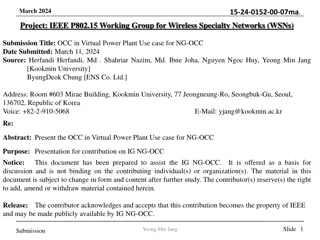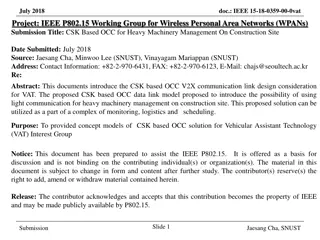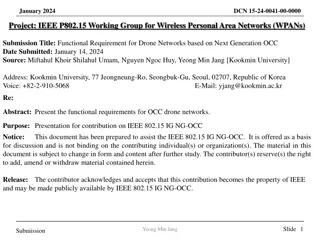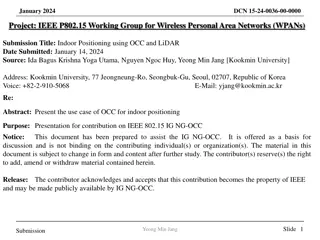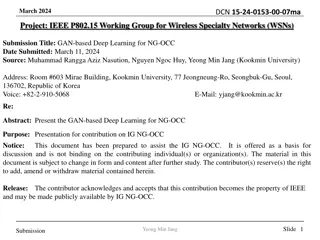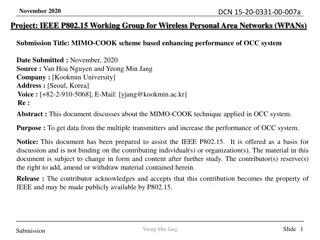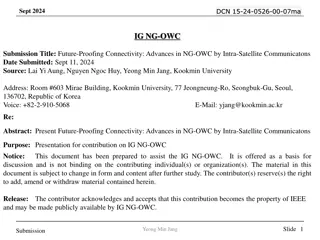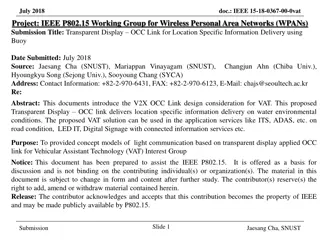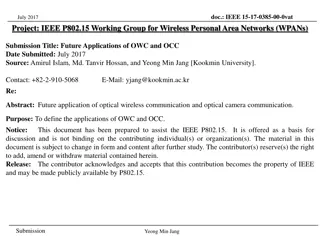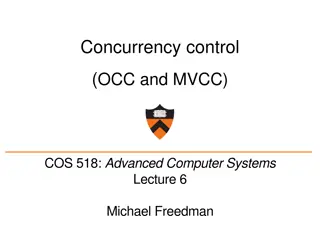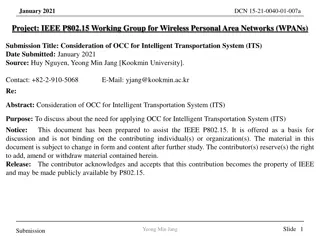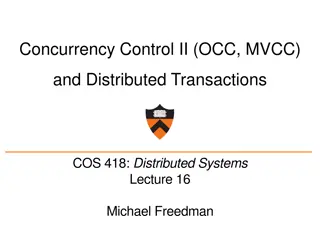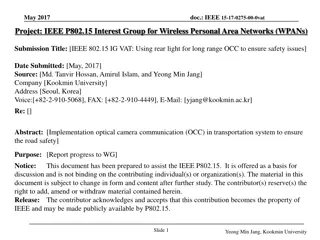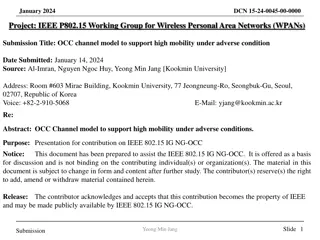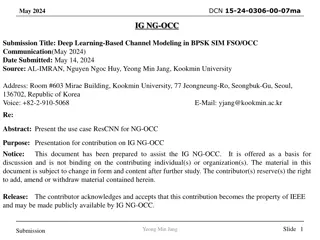NG-OCC Use Case for Building Management System
Building Management System (BMS) plays a vital role in urban life, especially for office workers. Integrating Next Generation Optical Camera Communication (NG-OCC) in BMS enhances centralized monitoring and AI-based Indoor Air Quality regulation, optimizing IAQ levels and energy efficiency while ensuring occupant comfort. This submission presents a use case exploring the integration of NG-OCC in BMS architecture, highlighting the benefits of real-time surveillance data and IoT sensor integration.
Download Presentation

Please find below an Image/Link to download the presentation.
The content on the website is provided AS IS for your information and personal use only. It may not be sold, licensed, or shared on other websites without obtaining consent from the author.If you encounter any issues during the download, it is possible that the publisher has removed the file from their server.
You are allowed to download the files provided on this website for personal or commercial use, subject to the condition that they are used lawfully. All files are the property of their respective owners.
The content on the website is provided AS IS for your information and personal use only. It may not be sold, licensed, or shared on other websites without obtaining consent from the author.
E N D
Presentation Transcript
15-24-0277-00-07ma May 2024 IG NG-OCC Submission Title: NG-OCC Use Case for Building Management System Date Submitted: May 14, 2024 Source: Khairi Hindriyandhito, Nguyen Ngoc Huy, Yeong Min Jang, Kookmin University Address: Room #603 Mirae Building, Kookmin University, 77 Jeongneung-Ro, Seongbuk-Gu, Seoul, 136702, Republic of Korea Voice: +82-2-910-5068 E-Mail: yjang@kookmin.ac.kr Re: Abstract: Present the use case AI for NG-OCC Purpose: Presentation for contribution on IG NG-OCC Notice: This document has been prepared to assist the IG NG-OCC. It is offered as a basis for discussion and is not binding on the contributing individual(s) or organization(s). The material in this document is subject to change in form and content after further study. The contributor(s) reserve(s) the right to add, amend or withdraw material contained herein. Release: The contributor acknowledges and accepts that this contribution becomes the property of IEEE and may be made publicly available by IG NG-OCC. Slide 1 Yeong Min Jang Submission
15-24-0277-00-07ma May 2024 NG-OCC Use Case for Building Management System May 14, 2024 Slide 2 Yeong Min Jang Submission
15-24-0277-00-07ma May 2024 Contents Background NG-OCC for BMS Use Case in BMS Conclusion Slide 3 Yeong Min Jang Submission
15-24-0277-00-07ma May 2024 Background Building Management System (BMS) plays a crucial role in modern urban life, particularly for office workers who spend significant time indoors. It encompasses various systems crucial for building operation, including HVAC, lighting, security, and Indoor Air Quality (IAQ). Implementing IoT solutions equipped with sensors enables continuous monitoring of IAQ parameters such as temperature, humidity, CO2, and particle matter. [1] Integrating Next Generation Optical Camera Communication (NG-OCC) in BMS facilitates centralized monitoring and AI- based IAQ regulation, to maintain optimal IAQ levels while maximizing energy efficiency and occupant comfort. Slide 4 Yeong Min Jang Submission
15-24-0277-00-07ma May 2024 NG-OCC for BMS The architecture of the BMS commonly include a sensors for collecting data, then transmitting it based on chosen communication protocols whether it is a wired, or wireless (usually a radio frequency signal) as illustrated in the figure. [2] Aside from employed IoT, BMS would also require a camera which used for surveillance to ensure security of the building. This would lead to a more complex requirement in implementing BMS with both IoT and camera. With the integration of NG-OCC, one camera could get the information of visual data (surveillance) and data from the employed IoT sensors. Slide 5 Yeong Min Jang Submission
15-24-0277-00-07ma May 2024 Use Case in BMS Integration of OCC into IoT is a feasible approach to enable real-time data with its high-data rate capability. [3] The data received would contain both surveillance data and IAQ monitoring data in real-time with just utilizing one camera as OCC receiver. Based on the data received, it would then enable the AI-based IAQ regulation to detect occupancy based on surveillance data and forecast the IAQ based on both surveillance data and IAQ monitoring data. Based on the forecasted data then it would be able to properly control the HVAC to ensure comfort in the building. Slide 6 Yeong Min Jang Submission
15-24-0277-00-07ma May 2024 Conclusion The integration of OCC into IoT which would be used for BMS is feasible and would have several advantages: Reducing the required transmission module and communication protocol hence making the architecture simpler A high-data rate transmission for real-time monitoring and control in BMS NG-OCC protocols offer a solution to the limitations of traditional BMS with seamless multimodal data transmission from a room in a building to BMS. With simpler architecture, the potential failure point would be reduced to enhance overall system stability. Slide 7 Yeong Min Jang Submission
15-24-0277-00-07ma May 2024 Reference 1. Li, L., He, Y., Zhang, H., Fung, J. C., & Lau, A. K. (2023). Enhancing IAQ, thermal comfort, and energy efficiency through an adaptive multi-objective particle swarm optimizer-grey wolf optimization algorithm for smart environmental control. Building and Environment, 235, 110235. 2. Valinejadshoubi, M., Moselhi, O., Bagchi, A., & Salem, A. (2021). Development of an IoT and BIM-based automated alert system for thermal comfort monitoring in buildings. Sustainable Cities and Society, 66, 102602. 3. Herfandi, H., Sitanggang, O. S., Nasution, M. R. A., Nguyen, H., & Jang, Y. M. (2024). Real-Time Patient Indoor Health Monitoring and Location Tracking with Optical Camera Communications on the Internet of Medical Things. Applied Sciences, 14(3), 1153. Slide 8 Yeong Min Jang Submission


